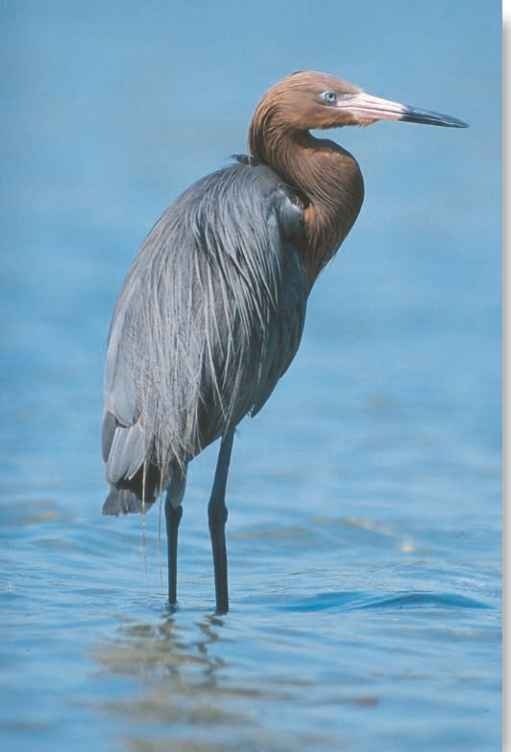ORDER
Ciconiiform.es
FAMILY
Ardeidae
GENUS & SPECIES
KEY FEATURES
• Occurs in two different color phases — a white phase and a dark phase
• Distinctive two-toned bill and shaggy neck distinguish it from other egrets
• Harpoons aquatic rey with its long,
straight bill
• Unlike other herons, feeds by chasing its prey or raking the bottom to stir it up
WHERE IN THE WORLD?
Found in North, Central and South America mostly along the Gulf of Mexico and the Gulf of California: Florida, Texas, Mexico, Cuba, the West Indies, Colombia and northern Venezuela
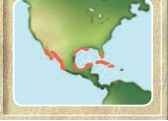
Lifecycle
The reddish egret is a very social bird except when feeding; it prefers to eat alone and boldly defends its feeding territory from a variety of other birds.
HABITAT

A Tidal flats The reddish egret relies on saltwater habitats, such as salt marshes along the coast.
Strictly a saltwater bird, the reddish egret typically occurs ir shallow coastal waters, salt pans open marine flats and along the shoreline; it is rarely seen fai from the coast. Since this heron is entirely coastal, it usually seek out islands and mangroves fo nesting, where there is less dange from predators. The reddish egret mostly ranges the Gulf of Mexico to the Bahamas and the Caribbean, as we as Mexico’s Pacific Coast and the Gulf of California
The white phase of the reddish egret has the same range as the dark phase; however, a higher percentage of white birds are found in the Bahamas, whereas a higher percentage of dark birds are found in Texas.
Occasionally, two dark-phase egrets will produce a white-phase offspring, but two white-phase egrets always produce white offspring.
Bird watchers love to watch the reddish egret feed — it often runs in zigzags to stir up prey, looking as though it is drunk and might topple headfirst into the water.
BEHAVIOR
The reddish egret is diurnal, usually feeding during the day and roosting at night. Like most herons, it is highly social and can be found in large flocks with other herons, spoonbills and cormorants. By forming large groups, these birds reduce the number of threats from predators by increasing surveillance. While some populations fly south for the winter, the reddish egret is only an occasional migrator; most populations remain in the same place year-round.
Majestic beauty The reddish egret is truly a unique and beautiful bird, with its two-toned bill and shaggy plumes (left), as well as its unusual habit of actively chasing its prey (Jbeloui).
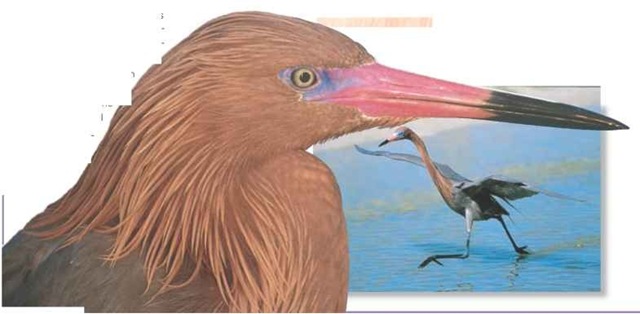
BREEDING
In some parts of its range, such as Florida, the reddish egret breeds almost all year-round, with several peaks throughout the year; in other places, such as South America, it breeds only once, usually in the summer. Normally social and silent, the egret becomes aggressive and vocal during courtship; males chase each other while stabbing with their bills to defend territories and call to win a female’s approval. A male walks back and forth in front of her while tossing his head and neck feathers. The pair nests either on islands, in low shrubs or on the ground, or in mangroves up to 15′ high. Egrets nest in large colonies with other birds, especially other herons. The female lays 2-7 eggs (usually 3 to 4) and the sexes share incubation for 25-26 days. Chicks of white-phase adults have white down, whereas those of the dark phase have smoky-gray down with a cinnamon head and neck; mixed adults have mixed offspring. The chicks fledge at about 45 days, but don’t reach sexual maturity until they are 2-3 years of age.
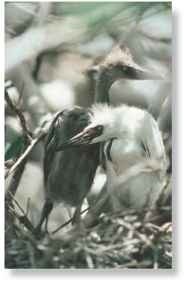
COLORFUL MARRIAGE
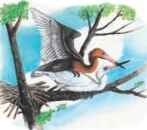
Mating…
A dark-phase male mates with a white-phase female high in a mangrove tree. The male spreads out his wings for balance.
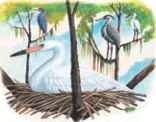
Sitting…
The female sits on her eggs located in a nesting colony with several other species while her mate is out hunting for food.
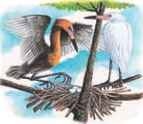
Switching…
As the male prepares to take his turn incubating the eggs, the female perches off to the side. She will leave to hunt for herself.
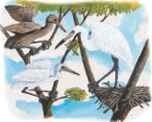
Feeding
Weeks after hatching, chicks of both color phases clamber at the nest site to greet their mother as she arrives to feed them.
CONSERVATION
The reddish egret is not globally threatened. However, it was formerly more widespread in North America and has suffered in the United States; it is hunted there for its feathers. The bird had disappeared from Florida in the early 1900s but, through conservation efforts, the egret has returned. Habitat destruction has also reduced the bird’s numbers.
FOOD & FEEDING
Although the reddish egret is gregarious, it is a solitary feeder and vigorously defends a feeding territory. It feeds mostly on small fish, but also consumes frogs, tadpoles and crustaceans. This egret prefers open tidal flats 6” or less in depth, but sometimes feeds in deeper water. As one of the most active feeders of the Ardeidae family the reddish egret usually chases its prey by walking quickly or running. The reddish egret also feeds by hopping, opening its wings to frighten prey, and foot-raking, a process where it rakes the bottom with one foot to stir up prey.
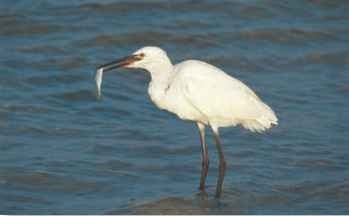
A Gone fishin’
Most of the reddish egret’s diet consists of small fish.
PROFILE
Reddish Egret
With its long legs, slender neck and pointed bill, the reddish egret is well adapted to feeding on aquatic prey while wading in shallow water.

CREATURE COMPARISONS
Reaching only 26″ long with a maximum wingspan of 40″, the eastern reef egret (Egretta sacra) is smaller than the reddish egret.The eastern reef egret inhabits rocky shores and coral reefs from Asia to Japan, the Philippines, Australia and New Zealand, unlike the reddish egret, which is found in the shallow salt pans and marine flats of North, Central and South America. Although both species have a white and dark-color phase, the dark phase of the eastern reef egret is entirely dark gray with a solid-yellow bill; the reddish egret has slaty-gray and rust plumage and a pinkish bill with a black tip.
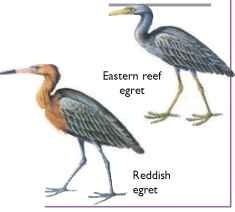
| VITAL STATISTICS | |
| Weight | 1-2 lbs. |
| Length | 26-32” |
| Wingspan | About 46” |
| Sexual Maturity | 2-3 years |
| Breeding Season | Varies with location |
| Number of Eggs | 2-7; usually 3-4 |
| Incubation Period | 25-26 days |
| Fledging Period | About 45 days |
| Breeding Interval | 1 year; occasionally 2 clutches per year |
| Typical Diet | Mainly small fish; also frogs, crustaceans |
| Lifespan | 12 years or more |
RELATED SPECIES
• The reddish egret is 1 of 13 egrets in the genus Egretta. Other members include the great white egret, E. alba, the pied heron, E. picata, the little egret, E. garzetta, and the Chinese egret, E. eulophotes. The heron family Ardeidae contains 60 species in 17 genera of herons, egrets and bitterns. The cattle egret, Bubulcus ibis, is the most common egret and is found worldwide.
